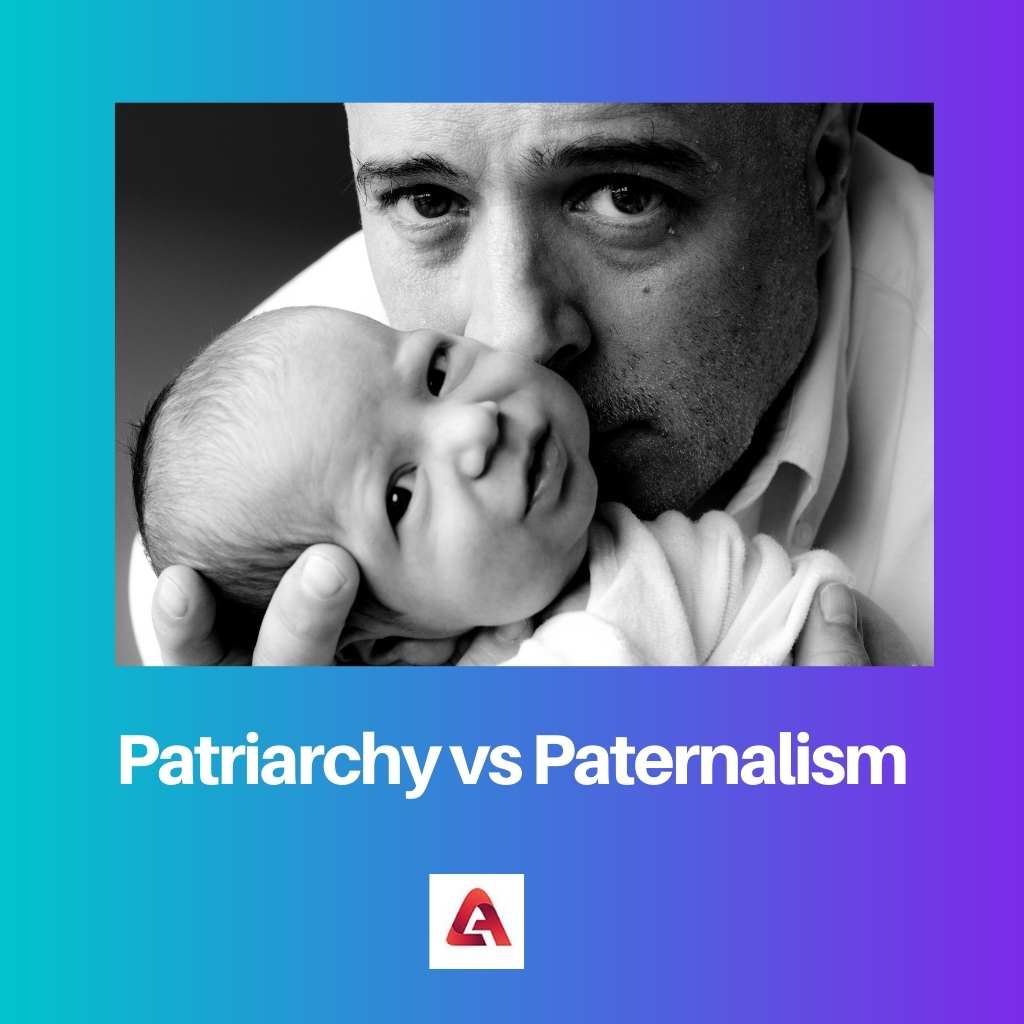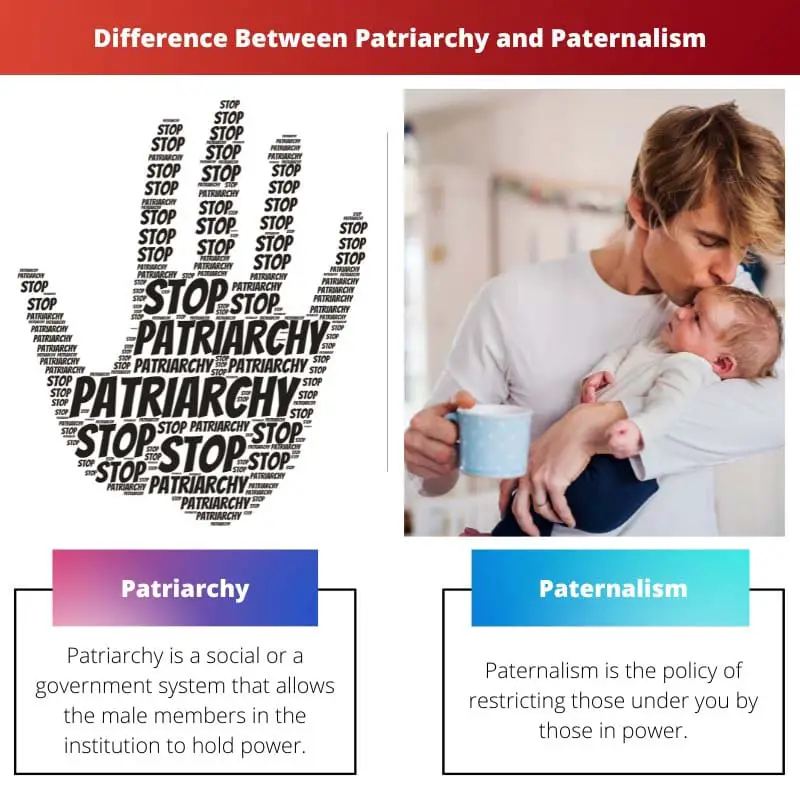The words patriarchy and paternalism are confused with each other due to the way they sound. The correlation between patriarchy and paternalism when put to use in practice.
Although patriarchy and paternalism are historically perceived as outdated and restrictive, the basic meanings and usage of the words vary widely.
Key Takeaways
- Patriarchy is a social system in which men hold primary power and dominate in roles of political, moral, and economic authority. In contrast, paternalism is an approach where a person or organization controls others for their perceived benefit.
- Paternalism may be well-intentioned and aims to protect or guide, while patriarchy perpetuates gender inequality and can lead to discrimination and oppression.
- Both concepts share similarities in the belief that men are responsible for providing guidance and protection but differ in the scope and implications of their influence.
Patriarchy vs Paternalism
Patriarchy is a social system in which men hold primary power and authority, at the expense of women and other marginalized groups. Paternalism is a form of control in which those in positions of power make decisions for those they see as less capable or less knowledgeable.

Patriarchy is the ancient system of society and government in which decision-making and control are given over to the elder male members of the family.
A highly backward concept, patriarchy is increasingly being recognized as an incorrect way of life. The women affiliated with these members are powerless and excluded from making any choices.
In the context of organizations and institutes, paternalism refers to a concept where leaders restrict the freedom of their subordinates, curtailing their responsibilities, making them dependent on their superiors.
Paternalism is practiced against the will of the subordinates. Paternalism is another unpopular practice that ultimately benefits no one despite the name.
Comparison Table
| Parameters of Comparison | Patriarchy | Paternalism |
|---|---|---|
| Definition | Patriarchy is a social or a government system that allows the male members in the institution to hold power. | Paternalism is the policy of restricting those under you by those in power. |
| Gender Constraints | Men hold power. The decision-making process excludes women. | Paternalism is not exclusive to any gender. |
| Government | In a political environment, patriarchy refers to the refusal of women to participate in matters of government. | This could refer to the leader of a party or superior officer refusing to allow responsibilities handed to their subordinates. |
| Etymology | Patriarchy means the rule of the father. | It is derived from the word paternal, which refers to a fatherly treatment. |
| Office | Patriarchy in a work environment can be filed under gender discrimination. | A paternalistic approach in a workplace is called a dictatorship style of management. |
What is Patriarchy?
Patriarchy is one of those things that everyone has experienced at least once. Despite the many revolutionary changes that have hit humanity, Eve still takes the blame for Adam eating the apple.
The patriarchy is the structure of a social or governmental organization in which all power and authority are held by male members, regardless of whether they are personal members or members of the institution.
This doctrine dictates that men have all the power and are allowed to pull the strings.
Women are excluded from making decisions, expressing opinions, and obtaining equal rights.
Men have supreme power in this male-dominated patriarchal society. They can predominate in politics, leadership, social privilege, and other roles.
Patriarchy has been around for a long time, with unequal power relations between men and women being a historical and current issue.
Not only are the women denied freedom, but they are also denied their basic rights such as education, ownership of property, etc.
They are, therefore, disadvantaged and suppressed. This leads to a large disparity in the share of men and women in several fields.
In patriarchal families, the father or eldest male member has the authority to make social, moral, and economic decisions. Women are expected to be docile, submissive, and obedient.
What is Paternalism?
As the name suggests, paternalism refers to the system whereby the power held over subordinates restricts their freedom and denies their responsibilities.
Paternalism asserts that these restrictions are for the benefit of those below the superiors.
Under a paternalistic system, those in power undertake to take care of the needs of the subordinates and regulate their conduct.
However, paternalism can be more accurately described as the interference of an individual in another person’s interests against their will.
This is done by claiming that they are motivated or wish to defend the less powerful from potential danger.
Paternalism is increasingly being perceived as a power play that only offers a one-way advantage.
Paternalism can be categorized or identified when conflicting claims between individual liberty and authoritative social control. This distinction can set paternalism apart from specific control administered by superiors in a general situation.
However, there are several types of paternalism that can be executed to different degrees. It is categorized as soft, hard, pure, and impure paternalism.
Paternalism can also be used judiciously.
For example, governmental rules that enforce people to follow certain rules, such as wearing seatbelts or punishing those driving a motorcycle without a helmet, can be considered a positive display of paternalism.
Main Differences Between Patriarchy and Paternalism
- While patriarchy refers to a social or government system that doesn’t allow equal participation of women, paternalism refers to the restriction of subordinates by the people in power.
- Patriarchy is aimed at restricting freedom and encouraging power to rest with men. However, paternalism is not directed towards a particular gender.
- While patriarchy stands for the rule of the father, paternalism is derived from the adjective paternal, standing for a fatherly approach to work.
- Complaints can be filed against gender discrimination if patriarchy is found to be practiced in offices and business organizations. The autocratic or dictatorship style of management follows a paternalistic approach to the workplace.
- The concept of patriarchy denies women power, control, decision-making, property, making them suppressed. Paternalism aims to limit the individual’s freedom and regulate the responsibilities entrusted to them.

- https://journals.sagepub.com/doi/pdf/10.1177/0038038589023002005
- https://link.springer.com/chapter/10.1007/0-387-28662-4_20
